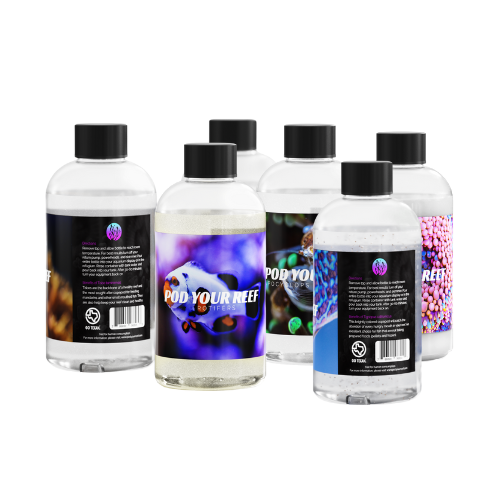Pod Your Reef
Texas Copepod Zooplankton - 6 Bottle Bundle
Texas Copepod Zooplankton - 6 Bottle Bundle
Couldn't load pickup availability
Texans know a thing or two about great food, and your reef is no exception. That's why we've created this limited-time bundle! Get everything you need to create a thriving and diverse micro-ecosystem in your saltwater aquarium with our bundle. This set includes
- Tisbe Biminiensis Copepods (1 bottle)
- Tigriopus Californicus Copepods (1 bottle)
- Apocyclops panamensis Reef Copepods (2 bottles)
- Rotifers (1 bottle)
- Reef Clarify (1 bottle)
With this comprehensive bundle, you can support the health of your coral, fish, and other invertebrates while keeping your water crystal-clear. Don't miss this opportunity to pod your reef and elevate your aquarium game!"
Apocyclops panamensis "Apo" copepods are an excellent species to seed a refugium or new reef tank. This copepod is a medium-sized copepod that is easier to see than our tisbe pod but not as large as our Tigriopus californicus "Tig" copepods, affording them the opportunity to reproduce faster than they could fall to predation.
Tisbe Biminiensis Copepods: This species of copepods has several life stages, including the egg, nauplius, copepodid, and adult stages. They are small in size, ranging from 0.2 to 0.8mm at each stage, and they feed primarily on algae and other small organic particles in the water column.
Tigriopus Californicus Copepods: These copepods are also characterized by their multiple life stages and small size, ranging from 0.2 to 0.8mm at each stage. They are known for their omnivorous dietary profile, feeding on a variety of phytoplankton, microalgae, and small zooplankton.
Rotifers: These tiny creatures have a well-defined life cycle, including the egg, trochophore, and adult stages. They are microscopic in size, ranging from 20 to 500 micrometers, and they feed primarily on microalgae and other small organic particles.
Recommended Light Level:
Recommended Flow Level:
Care Level:
Approximate Size:
View full details
Coral Care For Texas Copepod Zooplankton - 6 Bottle Bundle
-
Coral Lighting Level Recommendations with PAR Levels
-
Recommended Flow
-
Temperament
How To Acclimate Your New Coral
Proper acclimation is crucial for new coral arrivals due to the stress they endure before reaching you. Follow this simple process immediately upon receiving your livestock. The entire procedure takes less than half an hour.
-
Step 1: Dim the Aquarium Lights
The corals have been in complete darkness during transit and are not ready for high-output aquarium lighting. Turning off the lights reduces potential stress. Overexposure to light can harm corals that were grown under lower light conditions, causing severe damage within just a day or two.
-
Step 2: Transfer to a Larger Container
Use a small plastic tub for acclimating new corals. You can separate the corals into different tubs, but placing them together in one tub allows for enough volume to add aquarium water and prepare a pest control dip solution if needed.
-
Step 3: Slowly Add Aquarium Water
Add 1/2 cup of aquarium water to the tub every few minutes. Slow addition is crucial as corals are sensitive to changes in pH and salinity. Some aquarists prefer drip acclimation for a more gradual process, but be mindful of potential temperature drops. The entire acclimation should take no more than 30 minutes.
-
Step 4 (Optional): Dip Coral
To reduce the risk of introducing pests and parasites into your aquarium, consider using a pest control dip. Commonly used solutions include Coral Rx for treating pests like flatworms and nudibranchs, and Lugol’s Iodine for bacterial infections. Regular dipping, even when transferring corals between tanks, helps maintain a healthy aquarium environment.
-
Step 5: Place the Coral in the Tank
Select an appropriate location in your tank where the coral will receive suitable water flow and lower light levels initially. This allows the coral to acclimate to its new surroundings. If possible, use a quarantine system for initial acclimation, then follow the same steps to introduce the coral into the main display tank after the quarantine period.
-
Step 6: Enjoy
Now that your coral is properly acclimated and settled in its new home, take some time to appreciate its beauty and uniqueness. Observe how it interacts with its environment and other tank inhabitants. Enjoy the vibrant addition to your underwater ecosystem!
Feeding Corals
-
Photosynesis
Many reef-building corals host photosynthetic cells known as zooxanthellae within their tissues. This mutualistic relationship benefits both the coral and the zooxanthellae. The coral provides a safe environment and essential compounds for photosynthesis to these cells, allowing them to thrive.
-
Zooxanthellae
In return, the zooxanthellae generate oxygen and assist the coral in removing waste products. More importantly, they produce glucose, glycerol, and amino acids as byproducts of photosynthesis. These nutrients are vital for the coral's metabolic processes and overall health.
-
Macronutrients
The coral uses these substances to create proteins, fats, and carbohydrates, and to produce calcium carbonate, which is essential for building its skeleton. This symbiotic relationship is crucial for the efficient recycling of nutrients in the nutrient-poor tropical waters where these corals are found, ensuring their growth and sustainability.
Supplemental Feeding with Rotifers and Phytoplankton
For optimal coral health and growth, supplemental feeding with rotifers and phytoplankton can be highly beneficial. Rotifers provide a rich source of protein and essential fatty acids, while phytoplankton supplies vital nutrients and enhances the coral's natural diet. Incorporating these supplemental feeds can significantly improve the vitality and coloration of your corals, ensuring a thriving reef ecosystem.

